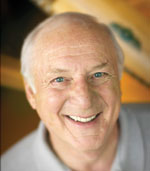 One question I am frequently asked is, “What is your favorite airplane?” I answer candidly that I don’t have a favorite. It depends on my mood and the purpose of the flight. My preference when taking a companion for a sunset flight on a warm summer evening is quite different than when I’m in the mood for aerobatics or traveling cross-country.
One question I am frequently asked is, “What is your favorite airplane?” I answer candidly that I don’t have a favorite. It depends on my mood and the purpose of the flight. My preference when taking a companion for a sunset flight on a warm summer evening is quite different than when I’m in the mood for aerobatics or traveling cross-country.
But when someone asks about the most unusual airplanes I’ve ever flown, well, that’s easy. Actually there are two in the hunt, and I’m not sure which of them is the weirder. You decide, but it would help if you went online and looked at photographs of these odd machines. (You might not believe what you see.)
You likely have heard about one of them, the Champion Model 402 Lancer. It is essentially an Aeronca Champ equipped with two engines and a nosewheel. Powerful? You bet. In cruise flight it can do on two 100-hp engines what a Cessna 150 can do on one. Well, perhaps it doesn’t perform quite that well. It is difficult to speak of the Lancer’s single-engine performance because it doesn’t have any. With one engine shut down and the other developing full power, the beleaguered twin descends at 250 fpm. That is because the fixed-pitch propellers cannot be feathered, and a windmilling propeller creates enormous drag. (The single-engine ceiling is way below sea level.) Stopping the prop, however, does improve performance slightly.
The idea behind the Lancer was to provide flight schools with an inexpensive multiengine trainer. But neither the concept nor the airplane flew very well. The Lancer was given burial rites after only 100 had been produced.
The student sits in front and paws a control wheel, while the instructor in the rear seat grips a control stick. Each has his own pair of ceiling-mounted throttles, but only the student is provided a mock landing-gear switch complete with green “safe” and red “unsafe” lights (even though the wheels are welded down). Presumably this helps him to develop the habit of operating “retractable” landing gear. The instructor royally chastises the student whenever he lands with an illuminated red light.
The elevator trim controls—each pilot has one—are downright dangerous. They look exactly like the sidewall-mounted throttles found in single-engine Champs and are in the same place, too. So if a student—or instructor!—reverts to habit and initiates a go-around by pushing forward on what is a throttle in other aircraft, the Lancer immediately plummets to the ground, thereby terminating the flight.
The airplane has a plethora of struts, braces, and other drag-producing protuberances. It is miraculous that it flies at all. The swayback airplane looks like a collection of afterthoughts.
Cockpit visibility is not bad; it’s terrible. The high engine nacelles project so far forward that they make the student feel as though he’s wearing a gigantic pair of horse blinders that results in disorienting tunnel vision. It’s not as bad for the instructor in the rear seat; it’s worse.
The fun part of flying a Lancer is observing the head-scratching bewilderment of those who watch you taxi by. It’s not so much fun, though, when they take out their rosary beads. The best lesson to learn from flying a Lancer is not to fly one again.
The other really weird airplane is the Transavia PL-12U Airtruk, an Italian design that I jokingly call a Transylvania Truck because it looks as though it could have been the creation of Count Dracula.
Imagine a large egg lying on its side. That’s the fuselage. The forward, top half of the egg is the pilot’s perch—where there is only one set of controls. One passenger sits immediately behind him but faces aft. It’s not bad not being able to look forward. By the time you see a hazard, it’s already been left behind. Should the pilot become incapacitated, there is little to do but pray because there is no way to access the flight controls.
If they are adventurous, three more passengers can sit in the lower half of the egg, and they, too, face aft. Only the pilot can see where he’s going.
Extending rearward from both sides of the little double-decker are twin booms like those on a Cessna Skymaster. But instead of being interconnected with a single horizontal stabilizer, each boom has its own little T-tail. The ungainly looking aircraft has a mid-wing configuration with a second set of low, stubby wings that add to the aerodynamic curiosity. They seem to have been added for good measure to ensure that the unorthodox-looking machine can get off the ground.
A horrible design feature is that if the flaps are extended during a crash landing, the lower-deck passengers cannot escape because the lowered flaps block the door. They, can, however, scramble into the upper deck and hopefully exit there.
Longitudinal stability is marginal to nil. As you accelerate after leveling off at cruise altitude, you have to add nose-up trim to maintain altitude, which, of course, is bass-ackwards.
The only time (thankfully) that I flew an Airtruk was 37 years ago from Sydney to the Australian outback and back. The most amusing part of it was visiting some out-of-the-way airports. At one place the local press came out to investigate the aeronautical curiosity that had descended upon the community. A photo of the airplane made the front page—above the fold.
Barry Schiff has flown 323 different types of aircraft. Visit the author’s website.



